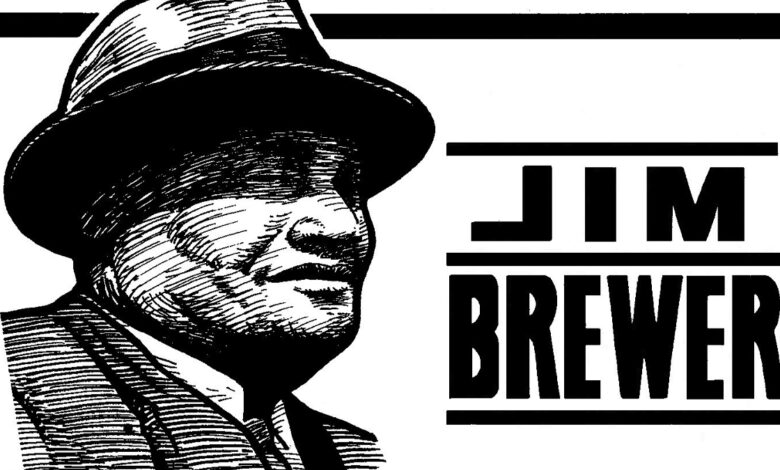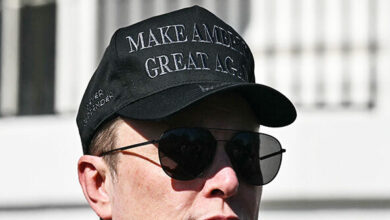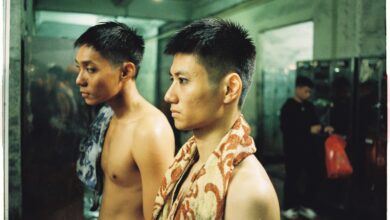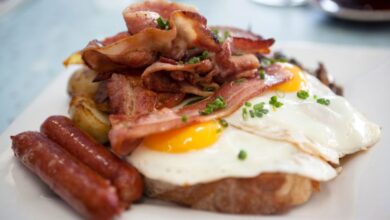Jim Brewer kept country blues alive in the big city


Since 2005 Plastic Crimewave (aka Steve Krakow) has used the Secret History of Chicago Music to shine a light on worthy artists with Chicago ties who’ve been forgotten, underrated, or never noticed in the first place.
When you think of Chicago blues, you probably hear electric guitar. Electrified blues dominated the genre after World War II, and its charged six-string crackle became the foundation of R&B and rock ’n’ roll. But for decades, guitarist Jim Brewer sustained the unplugged prewar sound of country blues—by the time of his death in 1988, he was one of its last original practitioners. His unadorned, idiosyncratic playing had a raw sincerity rarely heard in bigger, more polished bands.
Like many great Chicago bluesmen, Brewer came here from Mississippi, where he was born in the town of Brookhaven on October 3, 1920. The eldest of seven siblings, Brewer lost his sight to an illness as a child. Brewer’s mother sang gospel in church, while his father played blues guitar and piano.
Brewer’s father gave him a guitar when he was seven or eight, and he learned religious songs and popular blues and folk tunes. His mother wanted him to play gospel, but his father thought Brewer would make more money playing blues—and Brewer had to think about how to pay his own way during the Great Depression. As a teenager, he began to play his growing repertoire on the streets of Brookhaven. Soon he was traveling more widely.
“Brewer left home early and scuffled throughout the south in the 1930s, riding freights and sleeping in barns while making a living playing music on the small-town streets and at private parties,” wrote blues scholar David Whiteis in a Reader story on the occasion of Brewer’s death. “It was the classic hard life of the itinerant musician, made harder by his blindness.”
When Brewer’s mother died, his family migrated to Chicago. Whiteis says Brewer came here with them in 1940, while various liner notes say he followed a year later, arriving in 1940 or ’41. In any case, Brewer immediately began to play on 43rd and 47th streets, near the family home. He developed an affinity for blues guitarists of an older generation, including Big Bill Broonzy and Tampa Red. He also started busking at the famous Maxwell Street market, an important blues incubator where countless future legends cut their teeth. With his powerful voice and passionate playing, he could be heard without amplification, and he’d continue to turn up at the market for decades.
In the early 1950s, Brewer spent three years in Saint Louis. He played on the streets, on streetcars, and in bars, and for the hell of it he joined a washboard-and-jug band. After Brewer returned to Chicago, he met and married his wife, Fannie, who was also blind. She would often accompany him on Maxwell Street. Fannie’s mother gifted Brewer a solid-body electric guitar and amplifier—the first decent gear he’d owned. In the late 1950s, Brewer switched to singing almost exclusively gospel, weary of the trouble that dogged the blues scene.
Brewer would change course again during the folk-blues revival of the 1960s, a phenomenon driven by a new and mostly white audience. Two decades into his tenure on Maxwell Street, he was “discovered” in 1962 by two white college students, who asked him if he’d play some blues numbers. He made instant fans of them with his rootsy Mississippi Delta sound and his way of working a crowd.
“Brewer was the kind of musician the young enthusiasts had read about and dreamt of, but seldom seen,” Whiteis wrote. “He was a witty, garrulous entertainer whose ribald sense of humor, personal warmth, and soft-spoken eloquence allowed him to establish intimate rapport with an audience. ‘Take it easy, greasy!’ he’d chuckle to his guitar, in a voice alternately gritty and tender, after a particularly deft solo.”
Brewer’s encounter with those students led to a concert booking at Northwestern University. He arrived early for his set and used that time to visit No Exit, then still in Evanston. He auditioned for Joe Moore, the cafe’s owner at the time, and ended up with a regular gig at No Exit that lasted more than two decades.
The audience created by the folk-blues revival allowed Brewer to gig much more widely than before, at clubs, colleges, and festivals throughout the U.S. and Canada. He was afraid of flying, though, and only ever toured Europe once, very late in life. Whiteis quoted him as saying, “I’d rather see a man with no head walk toward me than fly!”
When he was in Chicago, Brewer kept up his Sunday appearances at Maxwell Street—according to a map of the market published in 1975 by Living Blues magazine, his regular spot was at 14th and Newberry. The reputation he’d built there had already led to his first published recording: Brewer’s 1960 version of “I’m So Glad Good Whiskey’s Back” appeared on the 1961 compilation Blues From Maxwell Street, which also featured the likes of Blind Arvella Gray (with whom Brewer often performed) and Daddy Stovepipe.
Paul Oliver, an English scholar of architecture and the blues, played a big role in assembling that collection (he wrote the liner notes and organized some of the sessions, including Brewer’s). In 1965, Oliver released another compilation, this one of recordings from the midwest and south. Brewer didn’t appear on the original LP release of Conversation With the Blues: A Documentary of Field Recordings by Paul Oliver, but when it came out on CD in 1997, it included several songs that paired him with Gray.
In 1964, Brewer appeared with Fannie on the compilation Can’t Keep From Crying: Topical Blues on the Death of President Kennedy, where the company they kept included Otis Spann and Big Joe Williams. In 1966, a Brewer track showed up on Ramblin’ on My Mind: A Collection of Classic Train and Travel Blues, which also included David “Honeyboy” Edwards, another beloved Chicago country bluesman.
Brewer didn’t release an LP under his own name till he was in his mid-50s: Vermont label Philo Records released his self-titled solo debut in 1974. The album captures a 1973 live set at Kirkland College in upstate New York, and it features driving Brewer originals, traditional numbers, and songs by blues elders such as Blind Lemon Jefferson, W.C. Handy, Tampa Red, and Big Bill Broonzy.
In 1975, Brewer appeared on the TV show Introduction to Folklore, talking about the meaning of the blues, his experiences on the chitlin’ circuit, and his influences. Thankfully he spends most of the show playing songs, demonstrating his gruff, lonesome pipes and alchemical acoustic guitar. Like many country bluesmen, Brewer didn’t bother to play in a strict meter when he didn’t have accompanists who needed to follow him, and his lines expand and contract like a breathing thing.
By that point, Brewer had been on TV and radio several times, and he’s featured in Mike Shea’s iconic documentary on Maxwell Street, And This Is Free. He was filmed in late 1964 playing gospel with vocalists Carrie Robinson, Mother Mary Northern, and Amos Gilmore as well as fellow guitarist Albert Holland (sometimes given as Hollins).
In the late 70s, Earwig Records owner Michael Frank became Brewer’s manager, and in 1983, Earwig released Brewer’s second and final solo album, Tough Luck. Frank produced the LP, portions of which were recorded in 1978 in DeKalb, in 1982 in Chicago, and live in 1980 at the ninth annual Gambier Folk Festival in Gambier, Ohio. Brewer plays originals and covers of prewar blues innovators such as Charley Patton, Tommy Johnson, and Big Maceo Merriweather.
I’ve read that Brewer sometimes departed from his usual arrangement of voice and acoustic guitar to play autoharp, piano, or electric guitar, and late in life he even used a drum machine. But because he recorded so infrequently, I haven’t been able to hear any of that. No matter the setting, though, he stuck to elemental, hardship-baked blues.
Brewer disliked being billed as “Blind Jim Brewer,” and he’s often quoted as saying, “My mother didn’t name me ‘Blind,’ she named me ‘Jim.’” He was a sensitive soul, preoccupied with mortality and worried about injury, perhaps because his blindness made him vulnerable.
After Brewer finished his only European tour, the promoter wanted to talk about a return trip, but Brewer refused to fly again. In any case, he probably wouldn’t have had time for another tour. Brewer died in his sleep from heart failure at his Chicago Housing Authority apartment on June 3, 1988. He’s buried at Burr Oak Cemetery in Alsip. His old pals Homesick James and Andy Cohen raised money for a gravestone at a benefit in Brookfield the month after he passed.
To close this tale, I’ll return to words published in the Reader almost 37 years ago, a few weeks after Brewer’s death. “Brewer let his deep blues feeling and versatility shine,” wrote David Whiteis. “He was a ‘songster,’ encompassing over half a century of black folk tradition and caring little for artificial distinctions among different kinds of music.”
“Along with David ‘Honeyboy’ Edwards and Homesick James, he was among the last of the seminal generation of acoustic guitarists who lived and played in the rich folk tradition that was the progenitor of Chicago blues and, through it, most of what passes for popular music today.” Amen.
The radio version of the Secret History of Chicago Music airs on Outside the Loop on WGN Radio 720 AM, Saturdays at 5 AM with host Mike Stephen. Past shows are archived here.

The Secret History of Chicago Music is sponsored by Dusty Groove Records. Find rare, new, and used LPs and CDs at dustygroove.com or in-store 9 AM–7 PM, 1120 N. Ashland.
https://chicagoreader.com/wp-content/uploads/2025/04/SH_jim_brewer_social.jpg
2025-04-02 12:57:50









